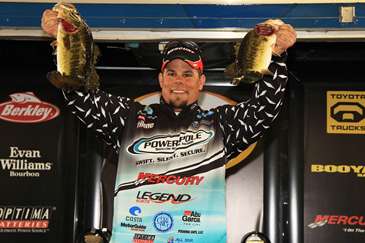
When a tough bite has experienced anglers scratching around for a limit, they’ll eventually reach into their bag of tricks and pull out one of those ace-in-the-hole, rainy day options. Among the most consistent is a hidden point of outflow. Find one of these spots and you’ll surely find someone with his nose to the current.
When a tough bite has experienced anglers scratching around for a limit, they’ll eventually reach into their bag of tricks and pull out one of those ace-in-the-hole, rainy day options. Among the most consistent is a hidden point of outflow. Find one of these spots and you’ll surely find someone with his nose to the current.
We’re not talking about the obvious feeder creeks that trickle and babble their way into a main body of water. Rather, a nice kicker may be lurking around some manmade — or at least man-influenced — point of water movement. Elite Series pro Chris Lane — a Florida native, now living in Alabama — has a deep log of such hidey holes for whenever his travels return him to Sunshine State waters. Be it an obvious storm water spillway or a subsurface pum
ping station clearing runoff from adjacent pasture lands, Lane notes that bass are drawn to these concentrated current zones. The temperature fluctuations and nutrient outpouring gather forage, and hungry largemouth patrol the edges to ambush meals.
Even the less discreet run-out spots are often overlooked because of surrounding weed growth, but observant anglers can score big by mentally connecting denser concentrations of emergent vegetation with the source of its fertility. Finding these gems takes a lot of backwater exploration, but the payoff can be huge. Lane showed me this deal one warm day on central Florida’s Kissimmee Chain.
When the normal milk run yielded few opportunities, Lane tucked his bass boat through a nearly imperceptible gap in a stand of willows and traversed a narrow creek leading to an inner artery cut between a forested shore and the adjacent pasture. At the end, a pumping station tasked with draining the cattle land kept the water boiling, and busting bass showed obvious delight at their clandestine feeding station. Anywhere bass find concentrated water movement delivering disoriented forage, bait selection becomes far less technical than in, say, bed fishing in high visibility. Lane fooled a couple of the pump fish on a crankbait, but topwaters, spinnerbaits and just about any plastic bait in your box will meet with instant aggression.
The key is integrating your presentation into the existing scenario. When a clear approach permits, try to cast right into the point of outflow — or upflow. Where aquatic plants grow densely, throw a weedless-rigged lizard or stickworm and crawl it over and through the thick stuff and see how long it takes for the hammer to fall. In either case, bass watching for the next meal will have plenty of company, so feeding competition drives immediate responses. As Lane notes, pasture lands flanking lake shores can offer multiple opportunities for atypical bass spots. Cattle watering holes and trenches formed by cow traffic fill up during the rainy season.
When lakes swell beyond their borders, rising water creates a bridge to these fish-friendly depressions. “Sometimes you’ll go over a little hill of pasture land and then it will open up into a spot that’s 10 feet deep,” Lane said. “Bass will get in there on high water and — because baitfish will settle in there — they don’t have any reason to leave.” Elsewhere, Lane said that inquisition can be an angler’s best guide. Noting that aquatic weeds will grow in solid patches unless interrupted by external forces, he said: “Watch for breaks and irregularities in shoreline vegetation. These [features] can be worth investigating.”
When running lake edges, he takes note of large hyacinth mats dipping far off the main shoreline. Floating vegetation requires depth to work its way into an area, so winds will pile the weeds into creeks and coves. However, when the wind blows from a different direction, it can push an inner gap between the weeds and the shoreline. This leaves a fishable hole that’s rarely visible to those who aren’t looking for it.
Sometimes, finding the hidden sweet spots requires you to pick and probe your way through irregular cuts and corridors, while other times it’s a game of brute force. With the latter, plowing through matted vegetation with the outboard trimmed high like an aquatic chainsaw is the only way to reach a promising area. To avoid whacking anything hard, probe potential passages with a stick or net handle before traversing. And watch those overhanging limbs! Snakes and spiders occasionally dwell there, and unannounced visits will be poorly received.





